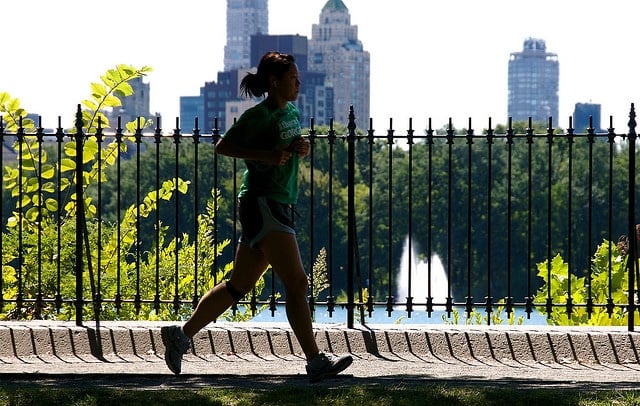Why can’t I lose weight while running?
If you don’t already know the answer to that question, then this post is perfect for you.
Running & Weight Loss Results
Running is the best thing you can do to help you lose weight and keep it off for good.
If truth be told, the reason I started running in the first place was to lose weight, and chances you’ve started (or thinking about it) for similar reasons.
Scores of beginners take up running because, mostly, they want to lose weight.
In other words, running does help you lose weight.
Nonetheless, and as I have learned the hard way, running does not always lead to weight loss.
This is a hard one to swallow…
Just because you took up running, it doesn’t necessarily mean that you’re going to get a flat stomach.
In fact, even if you are following a healthy diet and are hitting the pavement on a regular basis, there is no guarantee for weight loss.
My Story
When I first took up running circa 2006, I lost around 25 pounds in the first few months.
However, I couldn’t keep the weight off—regardless of my efforts and how much I wanted to stay slim.
Within six months of my initial success, I gained about 15 pounds back, even though I was running more than before and trying to set my diet in the right direction.
The irony, I know.
This frustrated the hell out of me.
All the same, I kept going after my weight loss goals.
I knew that I had no option other than staying consistent—giving up was not an option.
After a long process of trial and error, I was able to keep the weight off.
And today I’m going to share with you some of the main reasons you’re not losing weight as fast as you’d like to, along with a few tips to help you expedite the process and increase the chances of your success.
So are you excited? Then here we go…
Running But Not Losing Weight? – The Answer(s) You Seek
Running But Not Losing Weight Reason – 1. You are Gaining Muscle Mass
When you take up running, and for the first few months, your body responds to the new rigorous activity by making some adaptations and physiological changes.
One of these changes is a significant shift in your body composition as you gain muscle mass and lose fat.
How does that happen?
Running can increase muscles mass—especially in key running muscles, such as the glutes, quads, and calves.
In fact, you could be building muscle mass faster than you are shedding fat.
The Fix
The only thing you need to here is: Patience.
That’s it.
Once you keep up the good work, the fat will eventually burn off, and you’ll end up with a leaner and sculpted body.
Also, use other measurements for weight loss beyond the scale.
You might consider taking regular measures of your waist and circumference, or calculating your body mass index—BMI—via this online calculator.
This will give you a better ballpark figure of your percentage of body fat, according to your weight and height.
Running But Not Losing Weight Reason – 2 Bad Nutrition
This seems like a no-brainer, but even if you believe that you’re eating sensibly, you might be still off the mark.
Even if you exercise regularly, it doesn’t mean you can get away with eating a big mac and chocolate cake guilt-free and still lose weight.
That’s not how things happen in the real world.
A moderate 45-minute run may burn roughly 500 calories, but follow it with a soda drink, or a donut, and the calorie deficit is effectively erased.
What’s more?
Research published in JAMA revealed that subjects underestimated the amount of calories contained in a high-caloric food virtually 100 percent of the time.
The Solution
Here’s how to eat for weight loss when running.
Eat right. While your eating plan depends heavily on many factors, including your genes, body type, metabolism, the rule is to opt for natural, whole foods, at least 90 percent of the time.
Eat Well. Shoot for three meals a day satisfying enough that you can go for four to five hours before you feel the need for food.
Skip the sugar. Say no to sugary foods, bread, and anything else that’s processed.
The fewer the ingredients on the label, the better.
If you can’t pronounce, it’s likely not something you want to be putting in your mouth.
Practice Portion Control. Use cups and spoons to measure your serving sizes and make sure they’re appropriate.
Here’s the full guide.
Time your meals. When you eat also impacts your weight loss efforts. Here’s the full guide.
Monitor your calories. Use this simple online calculator to figure your daily calorie intake.
Additional resource – Clean keto food list for beginners
Running But Not Losing Weight Reason – 3 You Run too Much
Logging in too many miles without giving your body enough recovery time can lead to overtraining and all sorts of health troubles.
But that’s not the whole story.
Overtraining also has an impact on your weight loss vision.
If you an overtrained runner, especially when it comes to fluids, electrolyte balance, blood sugar, and stress levels, then you might be harming your thyroid and hindering your metabolic rate, all of which can compromise your weight loss efforts.
In other words, stress is bad for you—regardless of how much of healthy lifestyle you are championing.
The Fix
Give recovery the priority it calls for by doing the following:
- Eat for recovery with an emphasis on post-run eating and eating natural and nutritious food.
- Shoot for at least 7 to 8 hours of high quality interrupted sleep during the night’s time.
- Schedule recovery runs, recovery workouts, recovery days, and recovery weeks into your training program.
- Do your best to eliminate and reduce stress and its triggers in your life.
- For more recovery practices, check my post here.
Running But Not Losing Weight Reason – 4 You’re Not Running Hard (or Long) Enough
Some runners are able to lose a few pounds at first by just going for a few short runs around the block while opting for sensible diet guidelines.
But after a couple of months of doing the same thing, they suddenly hit a wall and stop seeing progress?
What’s gives?
The reason is actually quite simple.
The human body is pretty smart, and it’s designed to be as efficient as possible; this means that if you are running the same route at the same intensity and training level, your body will eventually adapt to the workload, and you’ll stop seeing results.
In fact, this is guaranteed way to encounter a weight loss plateau.
According to research conducted at the University of Tampa, running on the treadmill for 45 minutes at a steady pace promotes weight loss, but only during the first few weeks.
The Fix
Be consistent.
If you are serious about losing weight, make sure to schedule at least three runs per week, aiming for a minimum of 240 minutes of exercise a week.
Plus, and this is super important, try to diversify your training intensity and duration.
HIIT running workouts, such as sprints, hill reps and other HIIT workouts might be the exact thing you need to break a weight loss plateau and reach your weight loss running goals.
Thus, Instead of doing the same steady state runs over and over again, add a couple of interval training sessions to your weekly training routines, such as interval sprints and hill reps.
Also, incorporate a couple of cross training sessions to your training program to keep you consistent and speed up your fitness gains.
Spinning, Yoga, weight training, and swimming are some of the best options.
What’s more? If you are not into cross training, then I recommend that you find smart and practical ways to add more physical activity into your daily routine.
Here are a few things to consider:
- Stand more.
- Play with the kids.
- Get a stand-up work desk.
- Play sports with the kids.
- Exercise the dog.
- The list is almost endless.
Just get out there and be as active as possible.
Additional link – Slow running vs fast running for weight loss
Running But Not Losing Weight Reason – 5 The Scale is Just One Piece of a Much Bigger Puzzle
“The scale is a bastard trickster” as I like to say.
If truth be told, the scale might not be your best friend when it comes to keeping track of your weight loss progress—or lack thereof.
Why?
Well, it’s really simple.
Body weight tends to rise and fall by a few pounds from one day to the next.
This fluctuation depends, mainly, on hormones activity, the foods you are eating, dehydration level, etc…and when you hang your hopes on the scale, then you are actually setting yourself a vicious cycle of ups and downs.
So please, please remember this: the numbers on the scale do not tell the whole story.
The Fix
The best advice I can give you when it comes to tracking weight loss the right way is to use a variety of measurement.
As I have already stated, you need to opt for other ways than the scale to measure your progress.
Try some of these ways to measure your progress:
- Measure your body fat percentage once per month.
- Measure your waist circumference.
- Keep tabs on how well your clothes fit. Try on the same pair shirts or jeans every four to six weeks, and look for the subtle differences.
- Take before and after pictures on a monthly basis.
- Keep tabs on your emotional states and energy levels. Are you sleeping better? Do you have more energy? Are you feeling less stressed? Do you feel more alive? Etc.
- Keep tabs on your athletic performance. Is your athletic performance improving? How much you can you run? How long can you run? How fast can you run? Take these fitness tests on every six to eight weeks to see how your fitness level stacks up to the average Joe.
Running But Not Losing Weight Reason – 6 Unrealistic Weight Loss Expectations
I hate to break it to you, but weight loss is not something that happens overnight.
In reality, and contrary to popular belief, weight loss is a much slower process than the majority of people want it to be.
Don’t get me wrong.
Overnight success stories do happen.
In fact, it is even possible to lose a bunch of weight fast in the first few weeks of a weight loss resolution, but the truth is, this cannot be sustained.
And according to research, this is not the healthiest thing to do.
Therefore, if you are struggling with the scale, one reason might be that you just haven’t given it enough time.
And that’s it.
Additional Resource – Here’s how to much to run to lose weight
Fix it
Stop looking for short-term results.
Weight loss is more of a marathon, not a sprint.
Slow and steady wins the weight loss race…
Yeah, that’s easier said than done.
Here is your action plan:
Aim for no more one pound per week—that’s roughly 3500 calories.
As a rule of thumb, you should, ideally, shoot for a 300 to 500 calorie deficit a day if you are serious about shedding weight the healthy and sustainable way.
Give the process time, and with enough persistence and flexibility on your part, you’ll achieve what you are after.
Just keep in mind that everybody is different and responds differently to training routines and diet habits.
No suit fits all.
That’s the beauty of life.
And in the end, it pays for the long term to start accepting your body the way it is.
I hate to break it to you, but not everyone can look like a fitness model—no matter how entitled you feel and regardless of what the latest fitness magazine covers promise—we are all different.
The truth is, most of the fitness magazine covers and the fit-inspiration are often embellished and enhanced using special software—no one actually looks like that in real life (thank you Photoshop), and you shouldn’t be hard on yourself since you are not meeting any particular standard.
Running But Not Losing Weight Reason – 7 You Are Under Too Much Stress
Plenty of research has revealed that stress and weight gain go hand in hand.
Not convinced? Check the following studies:
Chronic stress can contribute to a host of health issues, including:
Elevated cortisol. Not only does this mess up your hunger hormone, but also cause extra belly fat storage.
Cravings. Research shows that we’re more likely to reach for ‘comfort foods’ that are rich in sugar and fat when we’re stressed.
Skipping Runs. When you feel like the world of the world is on your shoulders, it’s easy to put your run on the backburner in favor of a delicious waffle or a beer.
The Solution
Take a few minutes throughout your day to consciously check in with yourself and reduce your stress level.
Don’t take my word for it.
Research published in the journal Eating Behaviors revealed that regular meditation could help tame binge eating and decrease emotional eating.
Running But Not Losing Weight Reason – 8 You’re Sleep Deprived
Making time for your morning runs can mean less time for sleep, but it’s vital to get enough between the sheets hours if you’re trying to lose weight.
Why it’s the case?
Plenty of research has found that poor sleep to be one of the most common risk factors for obesity.
Here are a few:
Study 1
A study out of the University of Chicago found that sleep-deprived subjects opted for foods with twice as many carbs and fats as those who had enough sleep.
Study 2
One Mayo Clinic research found that sleep deprived subjects consume an average of 500 extra calories a day.
Study 3
Research out of the American Journal of Clinical Nutrition found that sleep deprivation can increase the chances of late-night snacking and unhealthy food decisions.
Study 4
Research proposes that lack of sleep may lower your resting metabolic rate, which is the rate at which your body burns calories when at rest.
In other words, by skipping on sleep, your body is cooking up a perfect recipe for weight gain.
The reasons sleep affects your weight are manifold. These include :
- Sleep deprivation can boost both insulin and leptin levels, resulting in the body becoming desensitized to their response.
- You’re more likely to get takeout for dinner then hit the bed late because you feel uncomfortably full.
- When tired following a bad night, you may choose to skip your workout or simply do less, burning fewer calories.
- Being tired and moody the next day sets your brain up to make bad food decision, research shows.
The Solution
Get at least seven to eight hours of quality sleep every day. That may require you to change your schedule around a bit, but it’s worth the effort.
Improve your sleep quality by doing the following:
- Build the habit of napping –30 minutes max—every
- Try different bedtime schedules and see which one works best for you. For example, go to bed at 11 pm so you can wake up at 7 am.
- Go to bed and wake up at the same time, including weekends
- Reduce distraction and light exposure in the few hours leading to bedtime
- Avoid stimulates such as caffeine or nicotine for three hours before bed.
Running But Not Losing Weight Reason – 9 You’re Losing Weight Without Realizing It
If you’ve been training hard lately and suddenly see the number on the scale go up, don’t panic.
The stats on the scale provide one variable, your absolute weight, which isn’t always the more reliable judge of what’s happening in (and to) your body.
By stepping on the scale day in day out, you’re simply measuring everyday fluctuations in your hydration levels and other trivial weight metrics.
What’s more?
Muscle gain can also be a culprit.
Sure, pounding the pavement doesn’t create a lot of bulk, but it does allow you to increase muscle mass, especially in your lower body.
In fact, if you’re running consistently enough to develop telltale running calves and quads, then you gained some muscle.
And since muscle weight more than fat, you might not see the scale move to the direction you desire, or you could put on a few pounds.
This is especially the case if you pick up training for the first time and/or are close to your ideal weight.
The Solution
Don’t jump on the scale every day.
It’s not unheard of for body weight to go up and down by a few pounds throughout the day.
Instead look for gradual, yet consistent, changes in your weight every three to four weeks.
To remove ups and downs from external factors form the equation, build the habit of weighing yourself at the same time of day and same day.
And make sure to do it first thing in the morning, before eating or getting dressed.
Use other measurements other than the scale to keep track of your progress.
- Measure your waist circumference
- Measure your body weight percentage.
- Get your body composition analyzed
- Track your body fat percentage.
Running But Not Losing Weight Reason – 10 You Have A Medical Condition
Maybe you’re not losing weight, despite running regularly and eating well, is because you have got an underlying health condition.
A host of medical conditions can hinder weight loss or cause weight gain. Among them are:
Cushing’s syndrome. Occurs when your adrenal glands release too much cortisol, resulting in the buildup of fat in your abdomen, upper back, and face.
Hypothyroidism. Happens when your thyroid is underactive, resulting in a limited production of the thyroid hormone, which is key for burning stored fat.
Polycystic over syndrome. Or PCOS, this condition is caused by a hormonal imbalance, affecting more than 5 million women in the US alone.
Insulin resistance. Or hyperinsulinemia, this is the umbrella term for host health issues thought to be rooted in insulin resistance.
Depression. You’re more likely to turn into eating to ease your emotional issues.
Some antidepressant medications (SSRIs) can also cause weight gain.
The Solution
Regardless of your exercise, diet, or lifestyle habits, if you’re piling up the pounds and don’t know why, consult with your doctor to rule out a medical issue as the cause.
Although you might feel tempted to give up, don’t. Most of these medical problems can be solved.
Conclusion
If you’re having trouble losing the pounds while running, you need to get real get back to basics—most of which I shared with you today (as well as this previous post).
It’s not only important to pay attention to what you’re putting in your mouth, but also how much sleep you’re getting, your stress level, your training intensity, and the fact that you might have medical issues that are sabotaging your weight loss efforts.
I know it’s hard to keep track off, but it’s worth the effort.
Just remember to take action, start small, and build these healthy habits gradually.
Then it’s just a question of time.
Losing weight is a messy business, especially when you’re a fat runner. There are no shortcuts nor silver bullets—and it requires hard and persistent work to see results—the type of result that works for the long term.
Please feel free to leave your comments and questions in the section below.
In the meantime, thank you for reading my post.
Keep Running Strong.
David D.
New to Running? Start Here…
If you’re serious about running, getting fit, and staying injury free, then make sure to download my Runners Blueprint Guide!
Inside this guide, you’ll learn how to start running and lose weight weight the easy and painless way. This is, in fact, your ultimate manifesto to becoming a faster and a stronger runner. And you want that, don’t you?
Click HERE to check out my Runners Blueprint System today!
Don’t miss out! My awesome running plan is just one click away.
Conclusion
The above reasons are the main ones to blame for not losing weight. So, if you’re still wondering what to do when you can’t lose weight, be honest with yourself and assess the possibility that you might be actually doing it to yourself.







